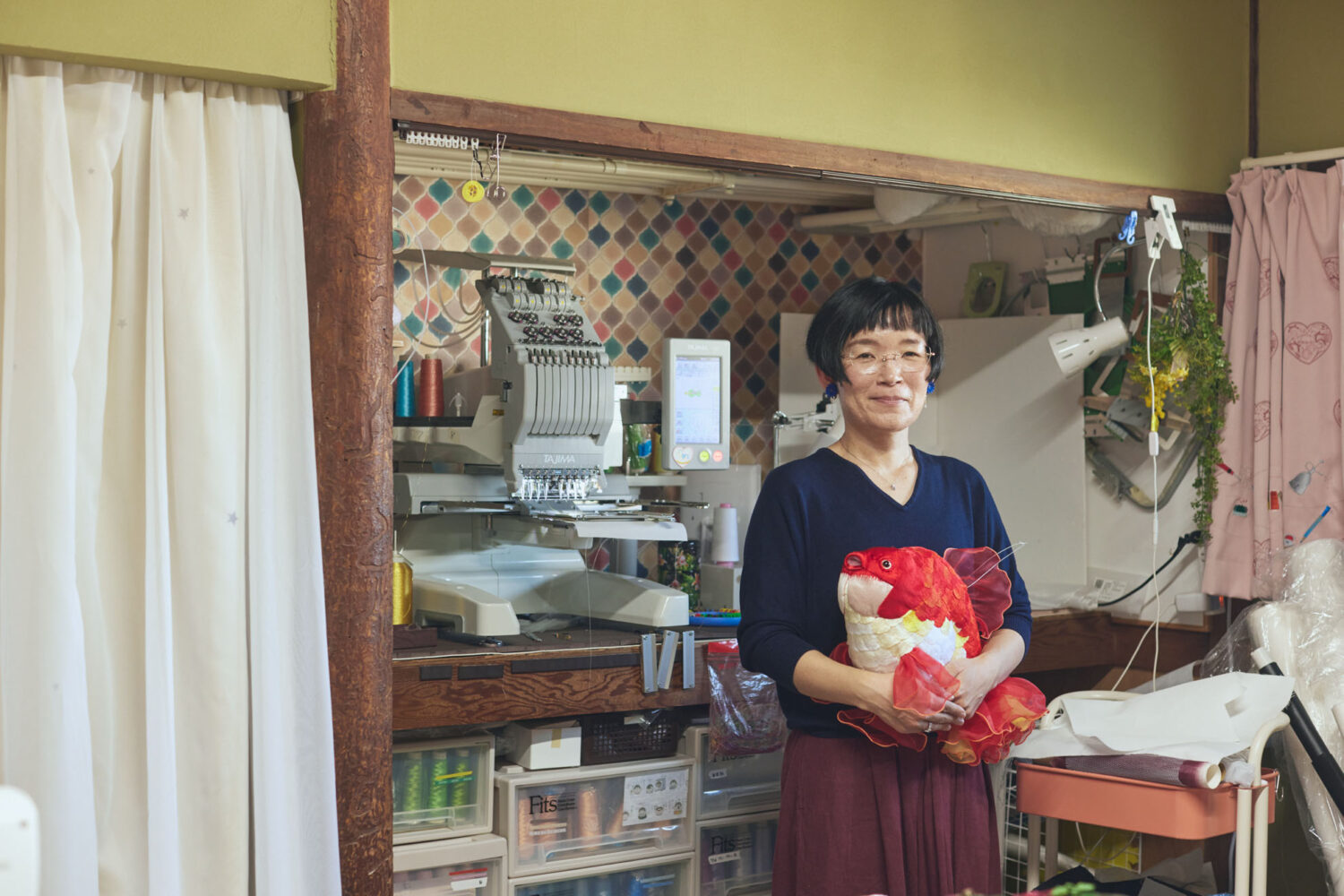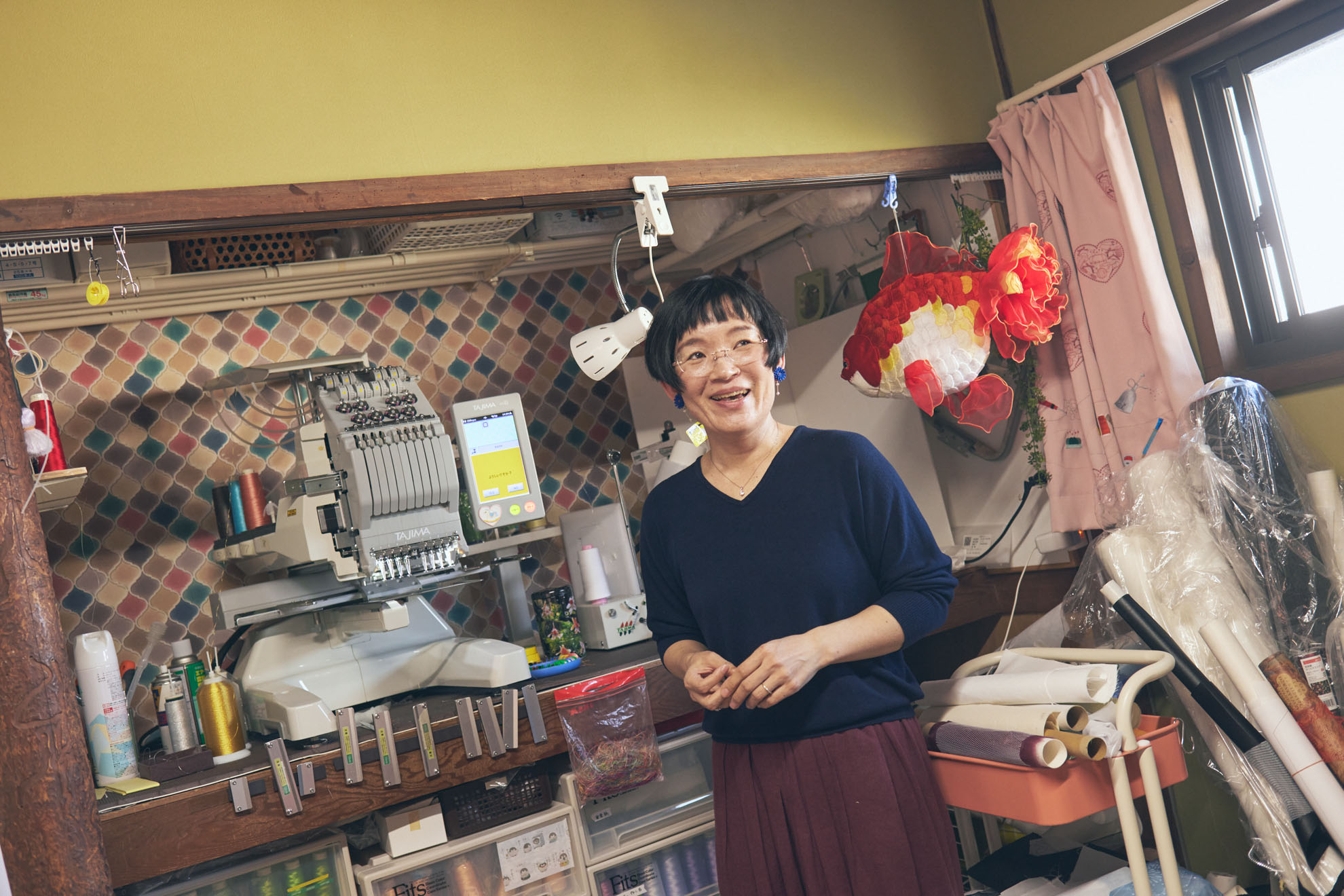Using the compact “SAI” embroidery machine, the embroidery artist known as “Sorairo Embroidery” creates numerous works expressing her original worldview. We asked her why she chose the SAI machine and what she focuses on in her creations.

"Tajima SAI, a reliable partner." An embroidery artist creates realism with embroidery stitches
Sorairo Embroidery
Sorairo Embroidery
This embroidery artist lives in Osaka. She creates original embroidery works primarily using goldfish motifs. In 2023, she won the “Sankei Shimbun Prize” Bronze Prize at the 16th AJC Creators Contest. She has received great praise for her works, which explore the new possibilities of embroidery.
Becoming an embroidery artist after working in the clothing industry
A lovely old traditional private house stands in a quiet residential neighborhood in Osaka Prefecture’s Hokusetsu Area. The sound of an embroidery machine can be heard coming from the second floor. This is the home and atelier of embroidery artist Sorairo Embroidery. One room on the second floor is her creative space, where her “SAI” fits snugly in the closet.
“SAI is the perfect size to fit in the closet, both in height and depth. It also looks stylish, and I really like that.”


Before working as an embroidery artist, Sorairo Embroidery worked in the clothing industry for around twenty years. She became interested in embroidery after crafting a hand-sewn bag for her child upon entering kindergarten. Subsequently, she learned the fundamentals of embroidery at a studio in Nagoya and embarked on her journey as an artist in earnest. Reflecting on that period, she expresses, “I think this is true for many people, but I get very excited when my ideas are translated into embroidery. It’s a feeling of accomplishment, like, ‘Look at what I’ve created!’ I was so happy that I fell in love with embroidery.
Since then, Sorairo Embroidery has been creating works based on goldfish motifs. After posting her works on social media, a gallery contacted her and asked to exhibit her work at an event. Figuring she’d need to increase the number of pieces for the event, Sorairo Embroidery decided to buy a new embroidery machine. “Until then, I had been using a home embroidery machine from a foreign manufacturer. But it was a single needle machine, so it was difficult to change the thread, so I decided to buy a machine with multiple needles. The reason I chose the SAI was because it had the ideal thread tension. I often use a thin fabric called organdy, but I can’t embroider on this fabric with a machine with tight thread tension. After trying out a number of different companies’ embroidery machines, the one with the ideal thread tension was SAI.

Producing a wide range of expression, without focusing on the embroidery aspect
She started using Tajima’s DG16 embroidery data creation software right about the same time she purchased her SAI. This decision arguably transformed the approach of Sorairo’s work. “The software I previously used, though beginner-friendly, had certain limitations. It automated some settings, restricting fine adjustments, leaving me feeling somewhat constrained. However, with DG16, we have the flexibility to tweak various settings to our preference. It’s akin to driving a manual transmission car. Switching my embroidery data software significantly enhanced the caliber of my creations.
Examining one of her notable pieces, a three-dimensional embroidered goldfish, one can see the realism it expresses, even in the details like the fins and face. It seems like it could start swimming at any moment.
Her piece “December Garden—Falling Autumn Leaves,” which won the Sankei Shimbun Company Bronze Award at the 16th AJC Creators Contest in 2023, depicts the scene of a garden when the autumn leaves are at the end of at their peak. It captures not only the fallen leaves but also the small details such as the moss on the chōzubachi stone wash basin—all were embroidered and express the Japanese worldview. “I was conscious of the fact I was expressing the beauty just the way I saw and felt it. Actually, I’ve always felt it was important to create with free ideas, without being bound by embroidery’s limitations. I may Working on this piece, too, I may not have really thought to myself, “I’m embroidering this.”


There is, however, one thing that Sorairo Embroidery has decided against doing. That is to add color after embroidering. The gradation is expressed only with the embroidery threads, without applying any coloring. This adherence to principle gives he works delicateness and impresses the observer.
Delicate yet robust qualities enhance SAI’s appeal
While the foreign-made embroidery machine she used before could create a variety of expression comparable to that of industrial machines, she said that it often broke down when she used it frequently. “The subtle detail it produced was appealing, but it took a lot of time to send it in for repairs. SAI provides the same level of subtle control while being highly durable and less prone to breakdowns. I consider it a dependable partner.”
Initially, Sorairo Embroidery created works as “products” with the intention of selling them, but at some point, she decided to create pieces without thinking of them as items for sale. Rather than making “products,” she would create “works.” After she changed her thinking and actively incorporate new methods of expression, the scale of her works expanded tremendously. Her attitude of taking on the challenge of doing what she has never been able to do before has resulted in a individual style found nowhere else. “I believe that my sense of humanity is reflected in my work. I don’t want my pieces to be merely aesthetically pleasing; I also aim for them to express my individuality and interests.”
Expressing what she feels through embroidery. Sorairo Embroidery says that with such subtle work, it is important to have good chemistry with the machine. “SAI just accepts what I want to express directly. I rely on my sense of touch to make small adjustments, as pushing a little harder or adjusting the thread tension. I think it’s much like a musical instrument. It feels like playing the piano, or rather, ‘embroidering in harmony with SAI.'”

She aspires to refine her techniques and achieve greater realism in her works Here we have learned about the thoughts of Sorairo Embroidery, who freely employs colors in pursuing the ideal in expression.





